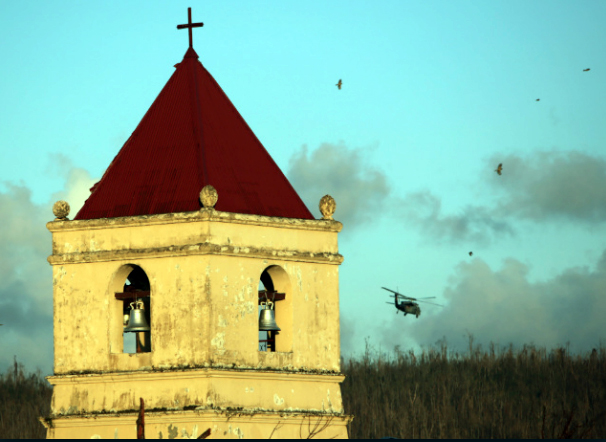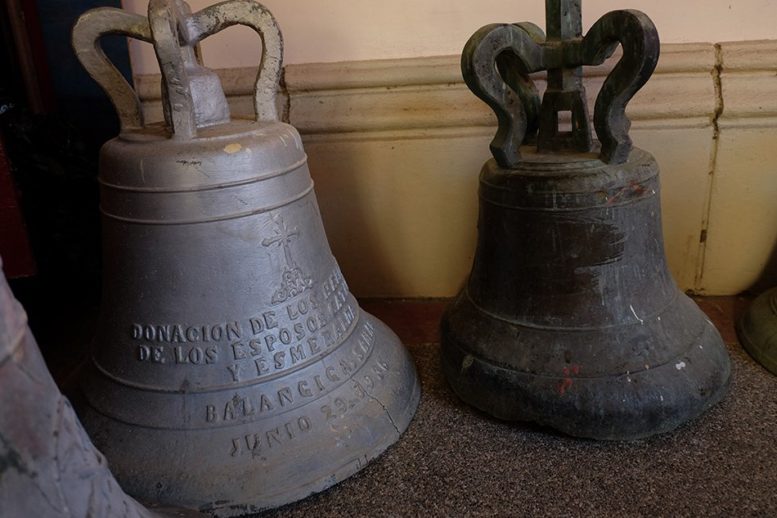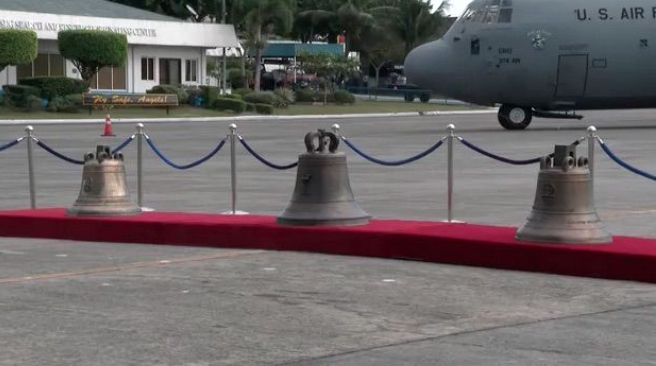The Maritime Forum this January stresses international relations and emphatically the DFA will host the 141st Maritime Forum.
As we enter a new year and get closer to the next decade, will there be an improvement in our relations with our erstwhile former closest ally and benefactor?
The United States has been the favorite “punching bag” of President Rodrigo Duterte from day one of his administration. He had often expressed in colorful terms his hatred for the United States in many of his day to day speeches, including the much-awaited State of the Nation Address (SONA) in July, 2017.
Reading the Philippine Star report on the 2018 SONA’s foreign policy thrusts, I listed a comprehensive foreign policy list:
- “Your concern is human rights, mine is human lives” (referring to both local and international critics);
- We will continue to assert an independent foreign policy;
- We will continue to reach out with other nations;
- The Philippines is to seek stronger bonds with fellow ASEAN countries;
- We will ‘defend’ Philippine interests in the South China Sea.
The blog, Duterte Daily on 15-December-2018 recalls that “President Duterte aired his call on the return of the Balangiga bells during his second State of the Nation Address (SONA) and also took time to join in the 116th Commemoration of the Balangiga Encounter Day at that municipality’s auditorium on 28-September-2017.”
“These Balangiga bells were taken by the American troops as ‘war booties’ after the encounter on 28-September-1901. For more than a century, the two bells were kept at the F.E. Warren Air Force Base at Cheyenne, Wyoming in the U.S.A., while the smallest bell was at the regimental museum of Camp Red Cloud in Uijeongbu, South Korea,” continued Duterte Daily.
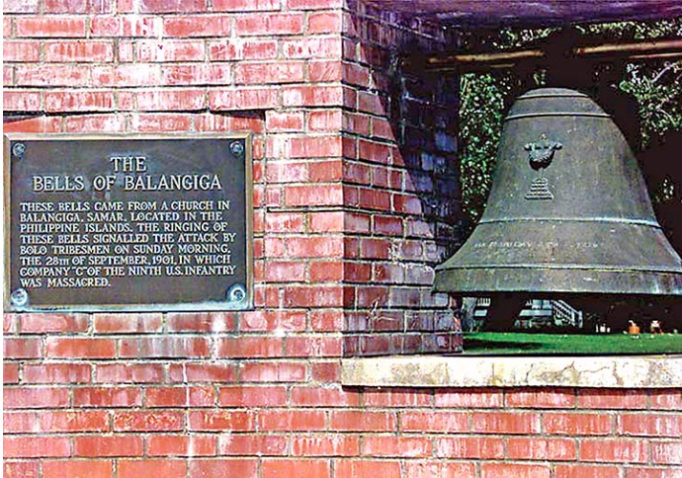
Bells of Balangiga at F.E.Warren Air Force Base, Cheyenne, Wyoming
Photo Credit: AP/Manila Bulletin.
The return of the Balangiga bells, to me, is a symbolic gesture indicating a willingness to overlook PRRD’s animosity to the United States.
US Defense Sec James Mattis’ speech at the Veterans Remembrance Ceremony at the Warren Air Force Base in Wyoming on 14-November-2018 where he officially announced the return of the Bells of Balangiga to the Philippines, as reported by in the website of the US-Philippines Society was an excellently worded reconciliatory speech.
History teaches us that nations with allies thrive and reminds us that all wars end. In returning the Bells of Balangiga to our ally and our friend—the Philippines— we pick up our generation’s responsibility to deepen the respect between our peoples – linking western people of the great state of Wyoming with people in eastern Philippines, not far from a town named for General Macarthur.
We return these bells with consideration of our present, but also with utmost respect for our past, one of shared sacrifice as co-equal brothers in arms. For we in the U.S. military do not forget those who stood by our side when the chips were down.
We do not forget the Filipino soldiers and people who fought with us, bled with us, and died with us in the dark days of WWII: In “the green hell of Bataan,” on “the rock” we call Corregidor, on islands and in landings from Leyte to Luzon.
We do not forget our shared sacrifice in Korea, where in 1951, at Yultong, the Philippines’ 10th Battalion Combat Team, though surrounded, held their position against the Communist Chinese onslaught, allowing the US 3rd Infantry to escape.
We do not forget how the Filipino people organized doctors and nurses in “Operation Brotherhood” in Vietnam. We recognize how the Philippines stands with America today in the fight against ISIS, against terrorism, a scourge that has struck their home as well.
In this world that is awash in change, we recognize the 117 years of enduring friendship between our people and comradeship in some of the toughest fighting in our nations’ history.
Last Monday, we observed Veterans Day: we honored those who defended our experiment in democracy, who restored our freedom and that of the free world, including the Filipinos who paid dearly at our side. Today, we aid the future generations by ensuring allies stand together in a future that is ours to shape; and so persuade potential adversaries that it simply isn’t worth it to gamble against Wyoming warriors who live by the cowboy code or their comrades-in-arms from the Philippines.
Our proud veterans, dedicated members of the US-Philippines Society and all those of good will in both the Philippines and the United States who labored so long for this moment—thank you! To those who fear we lose something by returning the bells, please hear me when I say: bells mark time, but courage is timeless. It does not fade in history’s dimly lit corridors, nor is it forgotten in history’s compost. Let me also speak briefly of a different set of bells, those that toll over the Manila American Cemetery, our largest overseas military cemetery of WWII dead. Inscribed there on its walls are the names of thousands MIA—American, Filipino and other nationalities.
As these bells ring, honored dead rest, freedom lives. Thank you
Very well said.
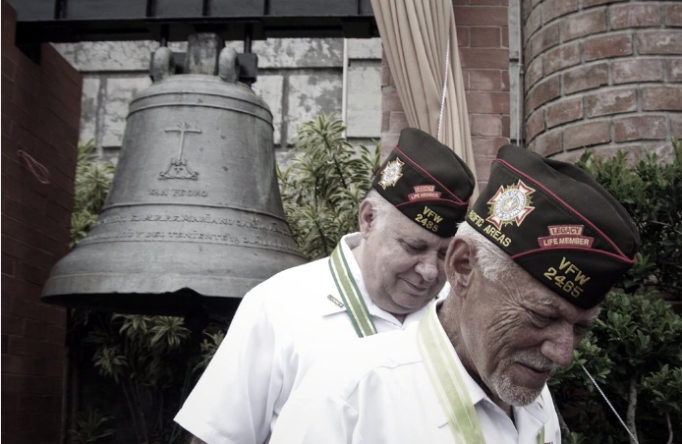
Bauang Bell taken in 1901 is returned to the Philippines. US War Veterans pay respect at San Pedro (St. Peter) Church. Photo Credit: The Inquirer National
I cannot recall when the effort to have the bells returned actually started, but it is safe to assume that the clamor came just after the Philippine-American War on the first decade of the last century.
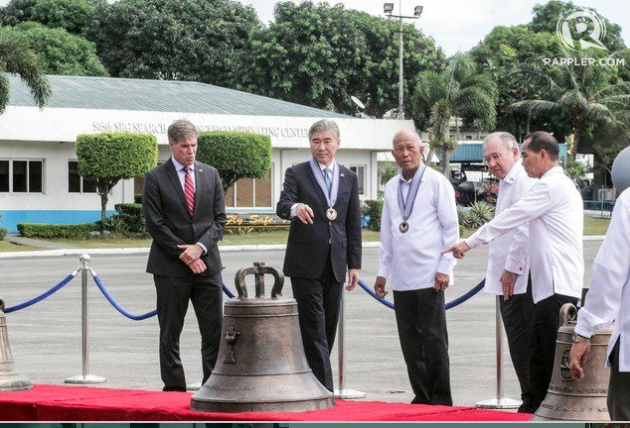
Defense Secretary Delfin Lorenzana and US Ambassador to the Philippines Sung Kim inspect the Balangiga bells during the arrival ceremony at the Villamor Air Base in Pasay City on 11-December-2018. Photo Credit: Ben Nabong and Lito Boras / Rappler
I grew up with the generation that saw peace, harmony and prosperity during the Commonwealth days, which resulted in absolute loyalty to “Mother America” prior to, during and after World War II, because of the goodwill that ensued as a result of the democratic US colonial administration. That was when we called the Philippine-American War the “Philippine Insurrection” as indeed it looked from American eyes, as we were American territory after the Treaty of Paris of 1898.
The 2017 SONA can perhaps be cited as the main reason why we, after more than a century, finally succeeded in retrieving the looted bells.
It wasn’t easy, I recall that having been a Defense and Armed Forces Attaché (DAFA) at the Philippine Embassy in 1985-88, that was one of our tasks, but just like when you deal in many things with the State Department on matters that do not coincide with their interest, you face a tough barrier to crack. Even prior to my posting, people at the Embassy were on it, including then DCM (later in the 2000s Ambassador) Raul Rabe, the Ambassador’s Special Assistant Capt Winston G Arpon PN and DAFA Team: Capt Domingo Tucay PN, Col Roman P Maddela PC, Col Melchor P Rosales PAF and Col Narciso Abaya PA.
I can remember one man, John Swallow, a US veteran married to a Filipina (she must be Waray) living in the Washington, DC area whom I met there during my DAFA tour. He had this dedication to that objective of returning the bells, pushing for it in veterans’ groups, Philippine-American community groups, the US Army, the DOD and with US legislators, spending time and money as well. We were not successful but succeeding staff after us pursued it still.
John Swallow later came to me once when I was President, National Defense College of the Philippines (NDCP) at Camp Aguinaldo, QC sometime in the early 2000s with his wife, and I again sent out a few emails to contacts in the US, including Sen John S McCain Jr., to support his effort. He was the one who told me one of the bells was with the 8th Army in Korea.
I forwarded to him the good news in late November, 2018 of the projected return of the bells by email as I still have his email address in my directory, reflecting his passion: balangiga@aol.com, although he probably already knew about it.
I posted this information in the Philippine Defense and Armed Forces Attaché (PHILDAFA) Forum and voila, a former PHILDAFA Washington, now Defense Secretary Delfin Lorenzana came back with this reply:
… I know John Swallow whom we at the Embassy fondly called: Juan Lunok. And you are right; he went for the return of the bells with great passion. He kept waving in front of us a letter from FVR designating him as rep for the return of the bell. He became very pushy, demanding and obnoxious that we stopped dealing with him. One morning sometime in 2013 our Consular General Dong Nolasco who goes to the Embassy very early caught him inside the embassy compound pouring gasoline. He wanted to burn the Embassy down. The police caught him and detained him. Only then did we find out he was suffering from emotional and mental breakdown. He was eventually released but was ordered by the judge that he could not come near the Embassy, the Chancery and Ambassador’s residence closer than 50 meters. I still saw him up to 2015 in gatherings of Filipinos outside the Embassy. I think he is still alive. He would be delighted to know that the bells are being returned.
Photo Credit: Coconuts Manila / Yahoo Finance.
As it turned out, John Swallow did know, as he acknowledged my email, but he had not at the time seen Secretary James Mattis’ speech.
This item will not be complete without noting the effort of the current US Ambassador to Manila, Sung Kim. The news about the return of the bells came earlier, including the posting of the speech of Secretary Mattis, but the details of the arrival were given during the traditional fellowship dinner on 15-December-2018 at the AFP Officers Club of the West Point Society of the Philippines and the PH Chapter of the US Naval Academy Alumni Association on the occasion of the Army-Navy football game, a tradition that started back in 1900.
The schedule for the arrival was announced by retired US Consul General Santiago “Sonny” Busa during that dinner and reiterated by Ambassador Kim during a call by the National Security Committee of the Philippine Council for Foreign Relations at Ambassador Kim’s office at the US Embassy the following Tuesday.
Sonny Busa, a Class 1976 graduate at the US Military Academy at West Point mentioned in his remarks after the dinner about his own efforts, first as a Consul at the US Embassy when requested by former President Fidel V Ramos, and later after retirement, as a resident of the Greater Washington area.
After he retired from the State Department, he returned to West Point as a Visiting Professor, but would eventually land a “pro bono” professorship at the PMA in Baguio. How this happened can be perused in an article he wrote on 20-December-2018 that was posted in the ManilaMail.us website:
Several years ago, I mentioned to my good friend, Delfin Lorenzana, now Philippine Secretary of National Defense, that I would find it interesting to teach at the PMA. I was at the time the Visiting Professor of International Relations at the United States Military Academy at West Point, the premier military school in the world in my unbiased opinion (take that all you Navy and Air Force Academy types).
To my amazement he emailed out of the blue last year to inquire if I was still interested in coming over. I hesitated because it would mean a separation from my wife, Ceres, and would mean leaving my active lifestyle at home where I am involved in many civic and academic activities.
All that paled in consideration to that fact that this was an opportunity to give back to the land of my birth and to do so in a manner that would influence future leaders of the country. I accepted the position on a pro bono basis because giving back means giving back completely.
Teaching the smartest and snappiest young men and women of the Philippines gave me an insight into what the Philippines can become.
A country that can produce such fine youth is capable of anything. All those who bemoan the condition of the country need only to spend some time with these cadets to suddenly become optimistic for the future.
What I love most about these cadets is that they mostly come from modest socio-economic backgrounds. They know what it means to be poor and they know what it takes to overcome those circumstances. You don’t see the children of the mega wealthy at the PMA. The graduates are motivated and driven by a desire to serve and to be a role model to their families and communities.
I will return to the PMA to do one more semester to teach Military Philosophy and Ethics. But I’m afraid that the tug and pull of being with the best of the Philippines will make me consider a longer stay. Will just have to tell my wife, Ceres, to come to Baguio. She actually is all for it. What’s there not to like?
From details in https://penmanila.ph/tag/busa/ posted 9-May-2016, one gets an idea of Sonny’s passion for the return of the three bells taken as war trophies by American troops from Balangiga, Samar in 1901 (two bells in a “Trophy Park” in a military base in Wyoming, and another at a military museum in South Korea.)
The Bauang, La Union bell
As it turns out, the Balangiga bells weren’t alone. In 1899, during the Philippine-American War, one Lt Tom Berry USA took a bell from the Church of St. Peter and Paul in Bauang, La Union and shipped it to America, where it languished for over three decades in some Army warehouse. “ In 1933, the same soldier—now Lt Gen Tom Berry, the Superintendent of West Point—had the bell taken out of storage to be displayed at the Catholic Chapel of the Academy,” according to the account.
The post continues:
Last January, acting on an inquiry from Fr. Ronald Raymund Chan of the Diocese of San Fernando, Lt. Gen. Robert Caslen, Jr.—the current Superintendent of West Point and a friend of Sonny’s—wrote Fr. Chan back to say that “The bell currently displayed on the grounds of our Catholic Chapel here is apparently the bell in question. According to our own records, the markings on the bell itself match all the descriptions you provided. While we have been honored to guard and display this bell for the past several decades, we would be glad to return the bell to its rightful home.
For a very interesting read on this and Sonny Busa’s role, which is noteworthy, please visit: https://www.pressreader.com/philippines/the-philippine-star/ 20160509/282578787252856
As announced by Busa at the Army-Navy reunion last December, the C-130 transport plane did land in Manila one Tuesday morning before Christmas carrying three bells taken from the Philippines a century ago during its war with America, ending a long-standing dispute between the two allies.
U.S. Ambassador Sung Kim turned over the “Balangiga Bells” to the Philippine government, which has called for their return for decades over the objections of some U.S. veterans.
“The history of these bells spans the entire relationship between the United States and the Philippines,” Ambassador Kim said during the ceremony at the Villamor Air Base, repeating what he told us at the US Embassy earlier: “Their return underscores the enduring friendship, partnership and alliance between our countries.”
The Philippine government eventually took the three bells to their original parish in Balangiga, Samar at a ceremony on Saturday, 15-December-2018.
I find Butch Dalisay’s parting statement in the Philippine Star item quite apropos:
I fear that many of us have forgotten how valuable our democracy is, and what artifacts like the San Pedro bell stand for. We seem to squander our votes on mindless whimsy and puerile petulance. I so desperately pray we can prove ourselves deserving of that bell, Sonny. How hollow its ring would be otherwise – a death knell for sanity and decency rather than the vibrant peal of freedom.
At Fort del Pilar, Baguio City, home of the Philippine Military Academy. stands a Philippine-American Memorial, which we founded through a project authorized by Secretary Eduardo R Ermita, followed through by Sec Gilbert Teodoro and Voltaire Gazmin, and inaugurated by no less than former President Fidel V Ramos in 2013.
Replicas of the 4 bells from Bauang and Balangiga, to memorialize the heroes of the Philippine-American War, and to emphasize the friendship and goodwill manifested by the United States, as well as the efforts of those who worked for the bells’ return, such as John Swallow, Lt Gen Robert Casten and especially Santiago “Sonny” Busa, deserve to be installed in that hallowed memorial.
